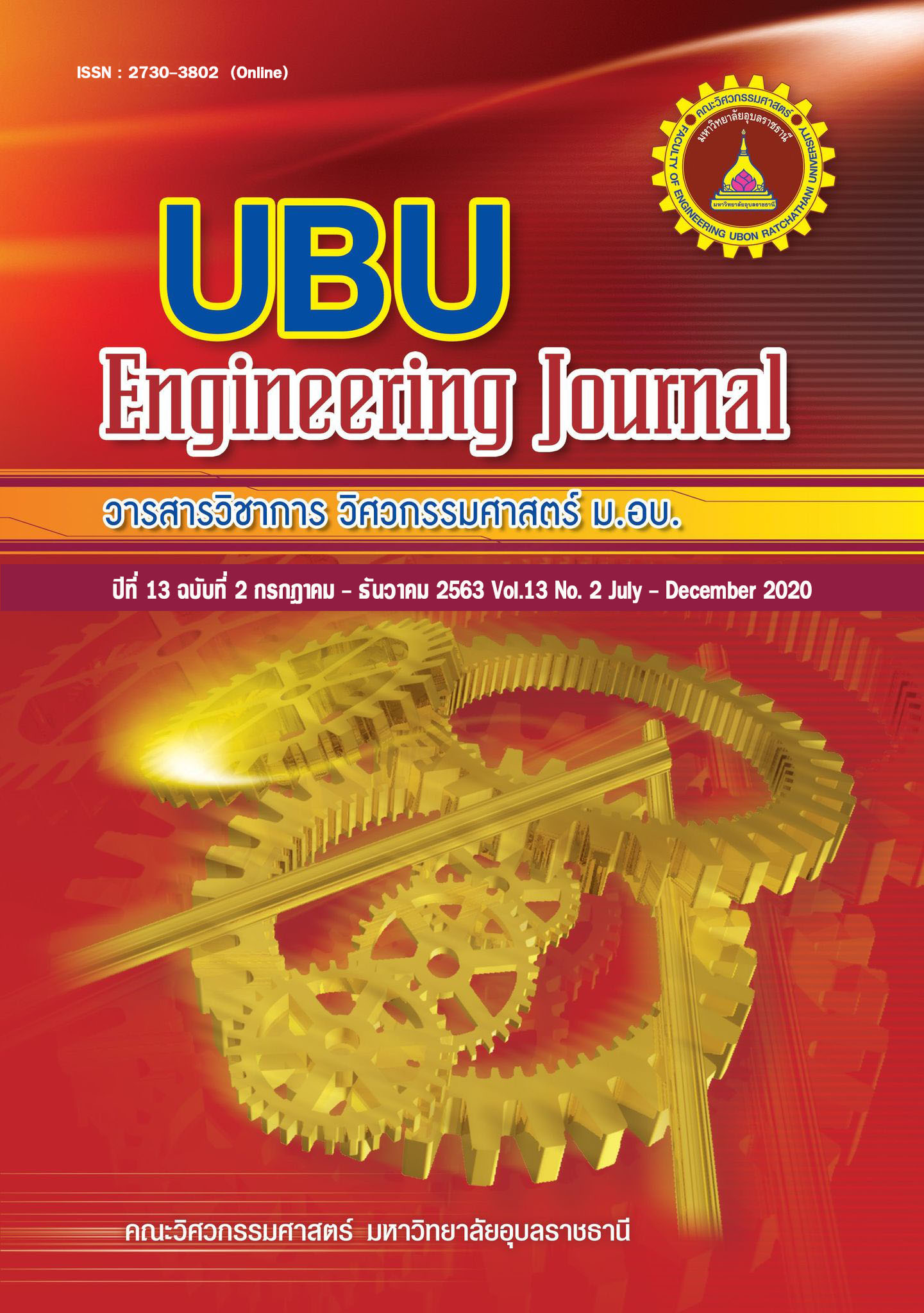ผลกระทบของสารควบคู่ปฏิกิริยาที่ส่งผลต่อสมบัติทางกลและสมบัติทางกายภาพของ คอมโพสิตพอลิแลคติกแอซิดผสมกากกาแฟ
Main Article Content
บทคัดย่อ
งานวิจัยนี้เป็นการศึกษาความเป็นไปได้ในการนำพอลิแลคติกแอซิด และกากกาแฟมาสร้างเป็นคอมโพสิตที่เป็นมิตรต่อสิ่งแวดล้อม ประยุกต์ใช้การออกแบบการทดลองทางสถิติเพื่อทำการศึกษา 2 ตัวแปร ได้แก่ ปริมาณการผสมกากกาแฟ (ร้อยละ 10, 20 และ 30 โดยน้ำหนัก) และปริมาณของสารควบคู่ปฏิกิริยา (0, 1, 3 และ 5 ส่วนเทียบกับร้อยส่วน) ทำการผสมด้วยเครื่องอัดรีดสกรูคู่ และขึ้นรูปเป็นชิ้นงานสำหรับทดสอบสมบัติด้วยกระบวนการกดอัดร้อน ผลการทดสอบสมบัติและการวิเคราะห์ผลทางสถิติทำให้ทราบว่าการเพิ่มปริมาณกากกาแฟส่งผลให้ค่าดัชนีการหลอมไหล ค่าความแข็ง ค่ามอดูลัสความยืดหยุ่น และร้อยละการยืดตัวของคอมโพสิตสูงขึ้น สำหรับการเพิ่มปริมาณสารควบคู่ส่งผลให้ความต้านทานแรงดึงและมอดูลัสความยืดหยุ่นเพิ่มมากขึ้น แต่การวิเคราะห์การถดถอยทำให้ทราบว่าอิทธิพลของทั้งสองตัวแปรส่งผลต่อสมบัติในลักษณะสมการยกกำลังสองมากกว่าความเป็นเส้นตรง การวิเคราะห์สัณฐานวิทยาทำให้ทราบว่าไม่ควรผสมกากกาแฟสูงกว่าร้อยละ 20 เพราะจะส่งผลต่อความสามารถในการคงรูปและความเป็นเนื้อเดียวกันของคอมโพสิต ผลสรุปการวิจัยพบว่าควรผสมกากกาแฟร้อยละ 10 และเติมสารควบคู่ที่ 5 ส่วนเทียบกับร้อยส่วนทำให้สมบัติของคอมโพสิตมีสมบัติที่เหมาะสมกับการสร้างเป็นผลิตภัณฑ์และมีสี กลิ่น ของกากกาแฟซึ่งเป็นเอกลักษณ์เฉพาะตัว
Article Details
References
[2] นภัส ปัทมสัตยาสนธิ กัลทิมา เชาว์ชาญชัยกุล และณรงค์ฤทธิ์ สมบัติภพ. ผลของการบ่มเร่งสภาวะด้วยแสงยูวีและสารเคลือบผิวชนิดซีเรียมออกไซด์ที่มีผลต่อสมบัติเชิงกลและการเปลี่ยนแปลงโครงสร้างทางเคมีในคอมโพสิตระหว่างพีวีซีและผงขี้เลื่อยไม้. วารสารวิจัย มข (บศ), 2010; 10(2) : 1-9.
[3] ศุภศิษย์ ศรีอักขรินทร์ สันติ สุขสอาด วุฒิพล หัวเมืองแก้ว และทรงกลด จารุสมบัติ.การตลาดของผลิตภัณฑ์ไม้ประกอบพลาสติกในประเทศไทย. วารสารวนศาสตร์, 2555; 31(1) : 46-54.
[4] Andreas K. Wood Polymer Composites and their contribution to cascading utilization. Journal of Cleaner Production, 2016;110: 9-15.
[5] Yanjun X, Callum ASH, Zefang X, Holger M, Carsten M. Silane coupling agents used for natural fiber/polymer composites: A review. Composites: Part A, 2010;41 : 806–819.
[6] Yang S, Hyun JK, Hee JP, Bum LJ, Taek SH. Effect of compatibilizing agents on rice-husk flour reinforced polypropylene composites. Composite Structures. 2007;77: 45–55.
[7] Anuchit K., Utai M. Design of Experiment: Wood Composite Based on Crosslinked Polypropylene, The 18th International Conference on Composite Materials. 21-26 August 2011. Jeju island, Korea.
[8] Meekum U, Khongrit A. Toughening Of Wood Plastic Composite Based On X-PP, Proceeding of PPS-31:The 31st International Conference of the Polymer Processing Society, 7–11 June 2015, Jeju Island, Korea, doi: 10.1063/1.4942319.
[9] อนุชิต คงฤทธิ์, จิตติวัฒน์ นิธิกาญจนธาร. ผลกระทบของสารช่วยผสานที่มีต่อสมบัติทางกลและสมบัติทางกายภาพของคอมโพสิตพอลิโพรพิลีนผสมกากกาแฟ. วารสารวิชาการ วิศวกรรมศาสตร์ ม.อบ. 2018; 11(1): 18-28.
[10] Sarawut R, Watanachai S, Sarot J, Sunan T. Highly Filled Polypropylene Rubber Wood Flour Composites. Engineering Journal, 2011;15(2): 17-30.
[11] Mehdi T. Ghanbar E. Water Uptake and Mechanical Characteristics of Natural Filler-Polypropylene Composites, Journal of Applied Polymer Science, 2003;88 : 941-946.
[12] Sombatsompop N. and Chaochanchaikul K. 2004. Effect of Moisture Content on Mechanical Properties, Thermal and Structural Stability and Extrudate Texture of Poly(vinyl Chloride)/Wood Sawdust Composites. Polymer International, 53(9) : 1210-1218.
[13] Moe MT, Kin L. Effect of Environmental Aging on the Mechanical Properties of Bamboo-Glass Fiber Reinforced Polymer Matrix Hybrid Composites. 2002
[14] Chin-San W. Renewable Resource-Based Green Composites of Surface-Treated Spent Coffee Grounds and Polylactide: Characterisation and Biodegradability. Polymer Degradation and Stability, 2015; 121:51-59.
[15] García-García D, Carbonell A, Samper MD, García-Sanoguera D, Balart R. Green Composites Based on Polypropylene Matrix and Hydrophobized Spent Coffee Ground (SCG) Powder, Composites Part B. 2015; 78: 256-265.
